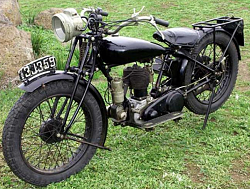Thanks olderdan! We've added your BSCY Taps and Dies to our Fastening category,
as well as to your builder page: olderdan's Homemade Tools. Your receipt:


Thanks olderdan! We've added your BSCY Taps and Dies to our Fastening category,
as well as to your builder page: olderdan's Homemade Tools. Your receipt:

New plans added on 11/22: Click here for 2,593 plans for homemade tools.
Thanks guys for all your motorcycling memories, you have all had more machines than me it would seem. My best bike was a pre unit 650 Triumph Trophy much modified with a BSA Goldstar front end. Bob Joyner cams, SW valve springs, 10.5:1 pistons etc. also running twin Wal Philips so called fuel injectors. After much playing with gearing it would just hit the ton in third and about 115 in top, I used it a bit in amateur sprinting, best time ¼ mile standing start was just under 15 sec.
This was also my road bike and to be honest I have no right to be here but it was the best fun ever. I sold it after putting in the third crankshaft, over revving by not having a rev counter (and oh yes getting married).

NortonDommi (Sep 22, 2017)
olderdan (Sep 24, 2017)
Just had a few beers with a friend I met on my first day at school who had moved to South Island, He and his partner have come North to look after his mum so good to catch up. A 1928 Triumph 247cc motorcycle has emerged from a shed and now there is a need to cut some change gears to cut the correct threads needed for items such as a front axle, foot pedal mounts etc.
Why did I feel the need to go metrickery? If I had an Imperial lathe none of the threads I deal with regularly would be a problem.
Olderdan, I have an inkling that I may be exploring making taps any tips?
olderdan (Sep 23, 2017)
We know that some metric threads can be cut with inch leadscrew but from my searching it would seem that the reverse is not that straight forward, especially
26 TPI. Maybe some of the more mathematically minded on HMT might help (I can think of a few).
To be honest I would probably buy them at the prices these days, they seem a lot cheaper than when I made mine.
In the UK I buy from Tracy Tools and they ship world wide.
By the way will the bike look something like this.

Good luck with it.
NortonDommi (Sep 25, 2017)
The magic ratio relating metric and inferial is 1.27. (The prime factors of 254 are 2 and 127). While a 127 tooth gear is doable, it's generally very unwieldy for the averge banjo. Approximations are in order.
Using my GEARFIND program, the simplest two gear approximation is:
47:37 = 1.27027... with an error on the order of 0.02%
If willing to go to a four gear set...
30:23 - 37:38 = 1.27002... with an error on the order of 0.002%
Using gears with larger numbers of teeth can produce better approximations but I've searched for small tooth count sets to keep them of reasonable diameter. You're free to download the program and explore it more fully if desired.
---
Regards, Marv
Failure is just success in progress
That looks about right - Mediocrates
Paul Jones (Sep 23, 2017)
The Wal Phiips devices were a pain to tune because the fuel/air ratio was adjusted on the fuel valve as was the throttle stop, which meant that after each adjustment of that you had to go and adjust the air valve opening and then the throttle stop.
I reversed the controls. That is; the throttle stop and cable were put on the air valve as was the ratio adjustment. So instead of 3 adjustments each time there was only 1. It made them so much easier to set up. In Australian racing at that time we could use any fuel and I made some WP clones with larger fuel valve spindle to take the larger holes needed for alcohol.
Click on pix for full size versions.
Here is a pic of the WP "injector" for those unfamiliar with it.
On the left is the original crazy linkage, on the right is my simple but very effective modifications.
Pit work 1960s style, adjusting my WP clone.
The O.E.C used a 4 bar linkage system for the steering but it was not a parallelogram layout. It had no physically defined steering axis as do most steering system, the 4 bar linkage gave rise to a "virtual" steering axis. It was known in its day a a good steering machine, however the geometry had a fundamental flaw in that the tyre contact patch moved rearward as you moved the steering away from straight ahead, Most if not all other steering systems move the contact patch forward when steered. The OEC layout meant that the steering was unstable under braking. It is likely that they only got away with it due to the abysmal brakes of the period.
Click for full size picture.
This was my take on the hub centre steered theme from the early 1980s
Last edited by tonyfoale; Sep 24, 2017 at 09:17 AM. Reason: Spelling correction.
There are currently 1 users browsing this thread. (0 members and 1 guests)
Bookmarks